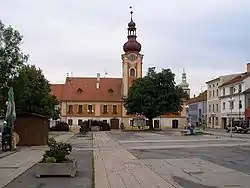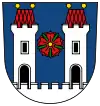Kaplice
Kaplice (Czech pronunciation: [ˈkaplɪtsɛ]; German: Kaplitz) is a town in the South Bohemian Region of the Czech Republic. It has about 7,300 inhabitants.
Kaplice | |
|---|---|
Town | |
 Town hall | |
 Flag  Coat of arms | |
 Kaplice Location in the Czech Republic | |
| Coordinates: 48°44′19″N 14°29′47″E | |
| Country | |
| Region | South Bohemian |
| District | Český Krumlov |
| First mentioned | 1257 |
| Government | |
| • Mayor | Pavel Talíř (KDU-ČSL) |
| Area | |
| • Total | 40.87 km2 (15.78 sq mi) |
| Elevation | 537 m (1,762 ft) |
| Population (2020-01-01[1]) | |
| • Total | 7,282 |
| • Density | 180/km2 (460/sq mi) |
| Time zone | UTC+1 (CET) |
| • Summer (DST) | UTC+2 (CEST) |
| Postal code | 382 41 |
| Website | www |
Administrative parts
Villages of Blansko, Dobechov, Hradiště, Hubenov, Květoňov, Mostky, Pořešín, Pořešínec, Rozpoutí and Žďár are administrative parts of Kaplice.
Etymology
The name of the town is derivered from Czech word kaple, which means chapel. Its origin is connected with St. Mary's Chapel which was built in the place of today's Church of St. Florian.
Geography
Kaplice is situated in a pleasant region at the foot of the Gratzen Mountains. It was founded in the early Middle Ages as the market village on an important trade route, connecting Upper Austria with South Bohemia. The route which was used for transportation of salt had important stopping places in the Austrian town of Freistadt and in Kaplice, so it was named after these towns. The advantageous position of the town was the reason for its change from a little settlement to a prosperous town.
History
Middle Ages
The first written mention of Kaplice originated is from 1257 and it recorded the existence of the parish church under the patronage of the monastery in Milevsko.
The ground plan of the newly established town, on the high left bank of the Malše, is evidence of the well-thought out colonizing project. From the oblong square not far from the church there is a rectangular network of streets, which is limited only in the north by the flow of the river.
In the written documents from the first half of the 14th century, Kaplitz is mentioned as the market town but the town privilege was not given to it until the year 1382. This privilege was later re-established by the new lords.
Kaplice as a tributary town belonged to the Pořešín estate, then to the Nové Hrady estate. In 1434, both Kaplice and Pořešín were acquired by Ulrich II von Rosenberg. After the Rosenbergs died out, the estates were inherited by the Švamberks, then to be handed over to the victors of the Battle of White Mountain, the empirical general Karel Bonaventura Buquoy. The town obtained a number of privileges which positively influenced its economic development. Nevertheless, this development had many times in the past been seriously afflicted with such catastrophes as frequent fires, desolation and robberies during the wars, especially during the Hussite Wars and Thirty Years' War. By the end of the 15th century, the town population had become German-speaking.[2]
Austrian monarchy
Until 1918, the town (bilingual names Kaplitz – Kaplice) was part of the Austrian monarchy (Austria side after the compromise of 1867), head of the district of the same name, one of the 94 Bezirkshauptmannschaften in Bohemia. The German name alone was used until the end of the 19th century.[3]
During the years 1771–1775 the priest Ferdinand Kindermann, pedagogue and later Bishop of Litoměřice, worked here and organized an exemplary school which became famous even beyond the borders of Bohemia.
After the abolition of serfdom and the system of authority,[4] according to the new administrative system, the town became the seat of the political and judicial district. It remained the district centre after many reversals till the year 1960.
Although Kaplice was the administrative centre of the large territory of Southern Bohemia, including the territory of Vyšší Brod and Nové Hrady, it remained a provincial town without a large economic base. In the year 1869 it had only 2,252 inhabitants and until the year 1921 the number had not changed.
Co-existence of the German-speaking majority with the Czech minority in the town was peaceful and almost without any problem. Kaplice was the common homeland for both nationalities. However, the growth of nationalisms at the end of the 19th century, and especially in the first half of the 20th century, raised the first serious conflicts.
Czechoslovakia
In 1921 Kaplice had 361 houses. It was mentioned as a market town and the statute of the town was bestowed to it on 9 July 1936.
The Germans in Kaplice first tried to break the town away from Bohemia after the fall of the Habsburg monarchy at the end of World War I and the proclamation of the Czechoslovakia but they did not succeed in bringing the town into German Austria. During the first republic, Kaplice remained a town with a majority of German inhabitants. The life of the Czechs could develop freely. Nevertheless, it did not continue for a long time. In the second half of September 1938 the members of Konrad Henlein's Sudeten German Party began to initiate disturbances and armed incidents against Czechoslovak authorities and they demanded annexation to Hitler's Nazi Germany. Their desire was fulfilled in the fall of 1938, with Germany's annexation of the Sudetenland. Upon occupation, the minority of the Czech inhabitants of the town and villages had to flee to the interior of Bohemia.
Upon occupying the region in October 1938, the NSDAP changed the name of the town from Kaplice (it's Czech name) to Kaplitz (it's German name). The name was changed back to Kaplice by the government of Czechoslovakia in 1945, after the war had drawn to a close.
After World War II
After the end of World War II Czechoslovakia was restored and Kaplice fell back again to Czechoslovakia. Czech former inhabitants returned, and many demanded German property under the Beneš decrees. Then majority of the town's population, which was German, was expelled from their homes and property, leaving the town with only 109 Germans (anti-fascists and in marriages with the Czechs), and the town depopulateded. In 1947, only 1,588 inhabitants lived here, mostly Czech colonists from Prague.
It was a complicated period of development for the town and this region during the next years. A lot of newcomers were defeated in the duel with hard conditions and the region of Kaplice did not become their homeland. It was also due to the Communist regime which started to take away the land from the newcomers by means of forced founding of state farms and co-operative farms.
In the year 1953, the eleventh year secondary school was established and after 3 years the first students graduated from the school. It was the foundation of the secondary school system in Kaplice. After temporary existence of the secondary agricultural school, the commercial academy and apprentice training centres were established here too.
The town began to develop again in the 1960s. New schools, new industrial factories and new housing estates were built here as new people were coming. Even though Kaplice is not the district centre, it remained the natural centre of this region.
During the next decades the number of inhabitants rose, especially in the 1970s and 1980s. By the end of the year 1997, there were 6,466 inhabitants in the town and 638 people in affiliated villages; Blansko, Dobechov, Hradiště, Hubenov, Květoňov, Mostky, Pořešín, Pořešínec, Rozpoutí, Rožnov, Žďár.
Until the year 1989 there was no possibility of travelling abroad – the location of the town near the closed border was disadvantageous. After the fall of totalitarism and the removal of "the iron curtain", the town was restored to life. There are many rebuilt and reconstructed houses, and new shops.
References
- "Population of Municipalities – 1 January 2020". Czech Statistical Office. 2020-04-30.
- Charles Higounet. Die deutsche Ostsiedlung im Mittelalter (in German). p. 330.
- Die postalischen Abstempelungen auf den österreichischen Postwertzeichen-Ausgaben 1867, 1883 und 1890, Wilhelm Klein, 1967
- Date needed, reference for understanding the concept "system of authority"
- "Partnerská města" (in Czech). Město Kaplice. Retrieved 2020-08-21.
External links
| Wikimedia Commons has media related to Kaplice. |
